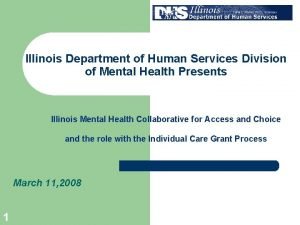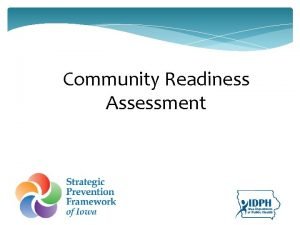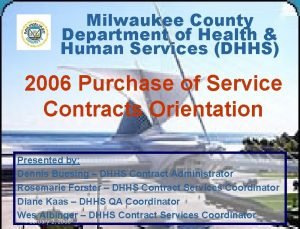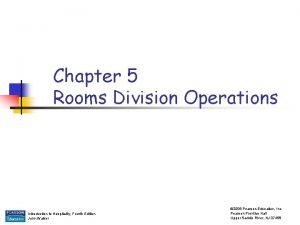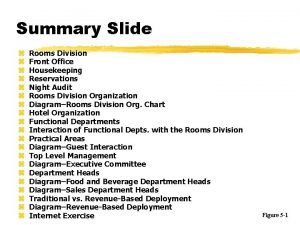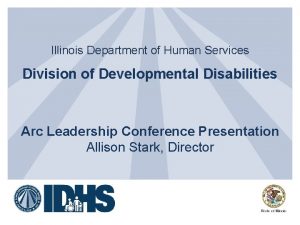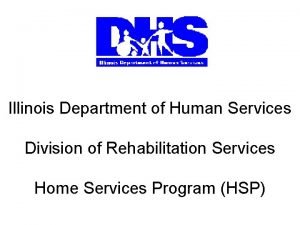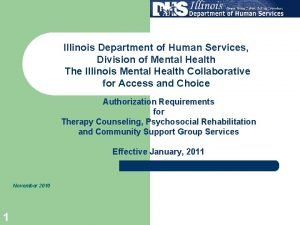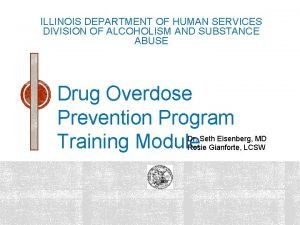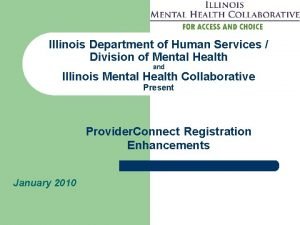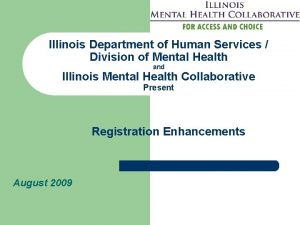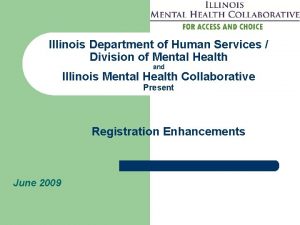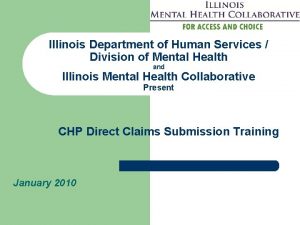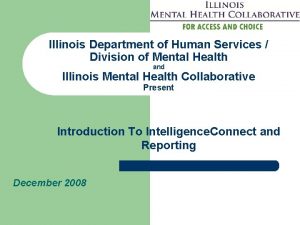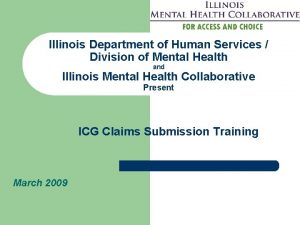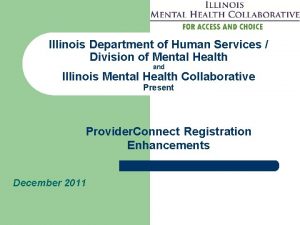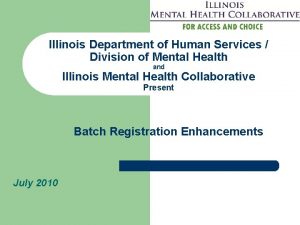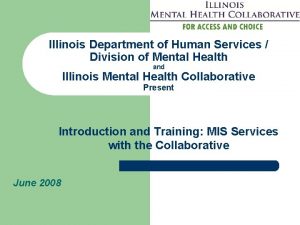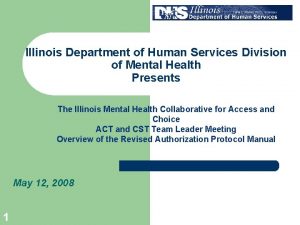Illinois Department of Human Services Division of Developmental



















- Slides: 19

Illinois Department of Human Services Division of Developmental Disabilities Arc Leadership Conference Presentation Allison Stark, Director

Overview of Presentation I. DDD Priorities • DDD Operations • Assessment & Investment in Services & Rates • Service Expansion II. HCBS Settings Rules III. Status of Illinois Statewide Transition Plan

DDD Priorities DDD Operations § Consistent and transparent ongoing communication § Establish and seat a DD Advisory Committee § Education for individuals, families and providers on waiver funded services offerings and access § Revision of Administrative Rules to reflect updates and new expectations of services

DDD Priorities DDD Operations § Strengthen, and create consistency, across our ISCs to better serve individuals and families § Rebuild the Bureau of Quality Management (BQM) and strengthen relationship with Bureau of Accreditation, Licensure & Certification (BALC) § Strengthen partnerships with Healthcare & Family Services (HFS), Illinois Department of Public Health (IDPH), Office of the Inspector General (OIG) and other Agencies and Departments that intersect with services for individuals with I/DD

DDD Priorities Assessment & Investment in Services & Rates § Work with Navigant Consulting on CILA and ICF/DD rate methodologies and rate recommendations that will stabilize the service system. § Continue to build mechanisms to orient or keep individuals with I/DD in community-based placements – Short-term Stabilization Home (SSH) expansion – SST follow-along for State Operated Developmental Center transitions – Rate recommendations for individuals with exceptional support needs

DDD Priorities Service Expansion § Expand competitive integrated employment (CIE) – Implement recommendations made by the State Employment Leadership Network (SELN) & the Rates Employment Training Subcommittee – Hire a Deputy Director of Supported Employment for the Division – Establish base level employment data and goals – Assess and change policies that discourage employment

DDD Priorities Service Expansion § Expand opportunities for the use of assistive technologies and remote supports to better meet individual’s needs and reduce reliance on physical staff support – Use data and feedback from AT pilot – Review waiver for AT coverage (initial and ongoing) – Provider training and TA to providers

HCBS Settings Rule

HCBS Settings Rule Key Takeaway: The HCBS Settings Rule ultimate goal is to ensure community access for individuals with I/DD to the same degree as people who don’t receive HCBS services.

HCBS Settings Rule For 1915(c) home and community-based waivers, the following settings are not compliant with the HCBS Setting Rule: § A nursing facility § An institution for mental diseases § An intermediate care facility for individuals with intellectual disabilities (ICF/DDs/SODCs) § A hospital https: //www. medicaid. gov/sites/default/fil es/2019 -12/requirements-for-home-andcommunity-settings. pdf

HCBS Settings Rule CMS requires review of settings that may isolate individuals. These include: § § Services provided on the grounds or next to a public institution Setting designed specifically for people with disabilities Comprised mostly of people with disabilities and staff Sites providing multiple types of services to people with disabilities in one location § Sites where people with disabilities have limited interaction with broader community https: //dspd. utah. gov/settings-rule/

HCBS Settings Rule The State must categorize and assess all settings: Category 1: Settings that fully align with federal requirements Category 2: Settings that do not comply with federal requirements but may comply with modifications Category 3: Settings that are unable to meet the federal requirement and require removal from HCBS program and relocation of individuals Category 4: Settings that are presumably not home and community based but for which the State may provide justification/evidence to federal CMS through Heightened Scrutiny process

HCBS Settings Rule For 1915(c) home and community-based waivers, residential settings that are compliant must: § Be integrated in and support full access to the community § Be selected by the individual among setting options § Ensure individual rights of privacy, dignity and respect, and freedom from coercion and restraint § Optimize autonomy and independence in making life choices § Facilitate choice regarding services and who provides them https: //dspd. utah. gov/settings-rule/

HCBS Settings Rule Additional requirements for provider-controlled settings: § A lease or other legally enforceable agreement providing similar protections to local and municipal rules and laws § Individual privacy with lockable doors, choice of roommate(s), and freedom to furnish or decorate the unit § Control of own schedule including access to food at any time § Access to visitors at any time § Physically accessible

HCBS Settings Rule Key Takeaway: Any modification of these conditions must be supported by a specific assessed need and justified in the Personal Plan; there must be an attempt for alternative strategies and have periodic reviews.

HCBS Settings Rule For 1915(c) home and community-based waivers, day settings must: § § § Not Isolate individuals from the community Not discriminate in any way Provide services in the most integrated setting Be chosen from a variety of options Provide opportunities to seek employment and work in competitive integrated settings https: //dspd. utah. gov/settings-rule/

HCBS Settings Rule Developing the Statewide Transition Plan: § As of December 2019 Illinois was only 1 of 5 states without an initial, or final, approved Statewide Transition Plan § All plans were to be approved by March 2019 § Implementation of the final, approved STP must be complete by March 2022 § HFS & DDD are working together to develop our plan

HCBS Settings Rule Things to keep in mind: § HCBS rules set the floor for compliance § CMS has made clear that states can set higher standards § States are encouraged to align their HCBS transition activities with their own state initiatives and other federal obligations: – State “Employment First” initiatives – State’s Workforce Innovation Opportunity Act plans – Activities to increase integrated, affordable housing – State’s Olmstead plans, settlement agreements or consent decrees

Questions? Allison Stark Director, Division of Developmental Disabilities Illinois Department of Human Services 600 East Ash-Building 400, Springfield, IL 62703 Tel: (217) 782 -6803 allison. stark@Illinois. gov
 Illinois department of human services
Illinois department of human services Iowa department of health and human services
Iowa department of health and human services Seattle human services department
Seattle human services department Milwaukee county human services
Milwaukee county human services Maine department of health and human services
Maine department of health and human services Delaware county human services
Delaware county human services Illinois department of rehabilitation
Illinois department of rehabilitation Wake county human services community services center
Wake county human services community services center Health care services lien act
Health care services lien act Siue human resources
Siue human resources Botanical name of mohari
Botanical name of mohari Office of academics and transformation
Office of academics and transformation Enterprise dedicated internet
Enterprise dedicated internet Imf
Imf Organizational structure of room division
Organizational structure of room division Room division department
Room division department Short division vs long division
Short division vs long division Syntehtic division
Syntehtic division Division traditional method
Division traditional method It is the shorthand method of polynomial division
It is the shorthand method of polynomial division
